Ariane 6 facts for kids
 |
|
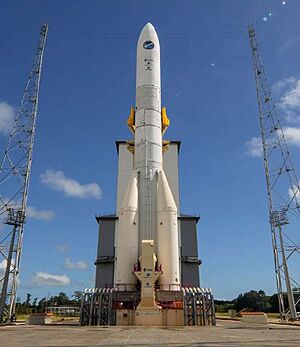
Mockup of Ariane 6 in the 64 configuration during testing at the Guiana Space Centre
|
|
| Function |
|
|---|---|
| Manufacturer | ArianeGroup |
| Country of origin | European multi-national |
| Project cost | €Lua error in Module:Math at line 586: attempt to call field '?' (a nil value). billion |
| Cost per launch |
|
| Size | |
| Height | 63 m (207 ft) |
| Diameter | 5.4 m (18 ft) |
| Mass |
|
| Stages | 2 |
| Capacity | |
| Payload to LEO |
|
| Payload to GTO |
|
| Payload to GEO | A64: 5,000 kg (11,000 lb) |
| Payload to SSO |
|
| Payload to LTO |
|
| Associated rockets | |
| Family | Ariane |
| Comparable | Falcon 9, Falcon Heavy, Terran R, H3, Vulcan Centaur |
| Launch history | |
| Status | Active |
| Launch sites | Guiana, ELA-4 |
| Total launches | 2 |
| Successes | 1 |
| Partial failures | 1 (VA262) |
| First flight | 9 July 2024 |
| Last flight | 6 March 2025 |
| Boosters – P120C | |
| No. boosters | 2 or 4 |
| Diameter | 3 m (9.8 ft) |
| Propellant mass | 142,000 kg (313,000 lb) |
| Thrust | 3,500 kN (790,000 lbf) each |
| Total thrust |
|
| Burn time | 130 seconds |
| Fuel | HTPB / AP / Al |
| First stage – LLPM | |
| Diameter | 5.4 m (18 ft) |
| Propellant mass | 140,000 kg (310,000 lb) |
| Engines | 1 × Vulcain 2.1 |
| Thrust | 1,370 kN (310,000 lbf) |
| Burn time | 468 seconds |
| Fuel | LOX / LH2 |
| Second stage – ULPM | |
| Diameter | 5.4 m (18 ft) |
| Propellant mass | 31,000 kg (68,000 lb) |
| Engines | 1 × Vinci |
| Thrust | 180 kN (40,000 lbf) |
| Burn time | Up to 900 seconds and four burns |
| Fuel | LOX / LH2 |
The Ariane 6 is a powerful European rocket designed to launch satellites into space. It was built for the European Space Agency (ESA) by a group of European companies, mainly led by ArianeGroup. This rocket is part of the Ariane rocket family and has taken over from the older Ariane 5.
This two-stage rocket uses special fuel: liquid hydrogen and liquid oxygen. Its first stage has an improved Vulcain engine, similar to the one on Ariane 5. The second stage uses a Vinci engine, which was made just for Ariane 6.
There are two versions of Ariane 6. The Ariane 62 uses two P120C solid rocket boosters, while the Ariane 64 uses four. These P120C boosters are also used on Europe's Vega rocket, which helps save money on production.
Ariane 6 was chosen in 2014 and was supposed to launch in 2020. However, there were some delays. Its first launch happened on July 9, 2024. Even though the rocket launched successfully, the mission had a small problem: the upper stage did not complete its final engine burn. The second launch was then moved to March 6, 2025. This launch successfully put its first commercial satellite, the CSO-3 spy satellite, into orbit.
Ariane 6 was designed to make launches cheaper and allow more missions each year. It aims to launch up to eleven missions annually, compared to seven for Ariane 5.
Contents
Meet the Ariane 6 Rocket
Ariane 6 comes in two main versions, each designed for different types of missions:
- Ariane 62 (A62): This version has two P120C solid boosters. It weighs about 530,000 kg (1,170,000 lb) when it lifts off. It's mostly used for government and science missions. It can carry up to 4,500 kg (9,900 lb) to geosynchronous transfer orbit (GTO) and 10,350 kg (22,820 lb) to low Earth orbit (LEO). The very first Ariane 6 launch in 2024 used this version.
- Ariane 64 (A64): This version has four P120C boosters. It's much heavier, weighing around 860,000 kg (1,900,000 lb) at liftoff. It's made for launching two satellites at once for commercial companies. It can carry up to 11,500 kg (25,400 lb) to GTO and 21,500 kg (47,400 lb) to LEO.
First Stage: The LLPM
The first stage of Ariane 6 is called the Lower Liquid Propulsion Module (LLPM). It uses one Vulcain 2.1 engine. This engine is powered by liquid hydrogen (LH2) and liquid oxygen (LOX). The LLPM is 5.4 m (18 ft) wide and holds about 140 tonnes (310,000 lb) of fuel.
Powerful Boosters
To give the rocket an extra push at liftoff, Ariane 6 uses either two or four P120C solid rocket boosters. These are also known as Equipped Solid Rockets (ESR). Each booster holds about 142,000 kilograms (313,000 lb) of fuel and provides a lot of thrust, up to 4,650 kN (1,050,000 lbf). The P120C engine is also used in the Vega C rocket. Sharing these engines helps reduce production costs.
Second Stage: The ULPM
The second stage of Ariane 6 is called the Upper Liquid Propulsion Module (ULPM). It's also 5.4 m (18 ft) wide, just like the first stage. It uses the same fuel, liquid hydrogen and liquid oxygen. The ULPM is powered by the Vinci engine, which provides 180 kN (40,000 lbf) of thrust. This engine can burn for up to 900 seconds and can restart up to five times. The ULPM carries about 31 tonnes (68,000 lb) of fuel.
Future Upgrades: Block 2
A more powerful version of Ariane 6, called "Block 2," is planned to start flying in 2026. This version will have larger P160C solid rocket boosters and an improved Vinci engine in the upper stage, which will have more thrust (200 kN (45,000 lbf)). These changes will allow the rocket to carry even heavier payloads. For example, the Ariane 64 Block 2 is expected to carry an extra 2 tonnes (4,400 lb) to low Earth orbit.
Development of the P160C boosters began in 2022. These upgraded boosters are 1 metre (3 ft 3 in) longer and carry an extra 14 tonnes (31,000 lb) of fuel. Many future launches, including 16 of the 18 planned Kuiper missions, will use this upgraded booster. The first P160C booster casing was built in June 2024.
Future Upgrades: Block 3
The European Space Agency, ArianeGroup, and CNES are also discussing an even further upgrade called "Block 3." This version would mainly improve the upper stage. The main reason for this upgrade is to support upcoming missions to the Moon, like the European Argonaut lunar lander project. A decision on this upgrade is expected in November 2025.
Rocket Nose Cone (Fairing)
The payload fairing is the nose cone at the top of the Ariane 6 rocket. It protects the satellites inside during launch. It's made from a strong, lightweight material called carbon fibre-polymer composite. The fairing splits into two halves when it's time to release the satellites. It comes in two sizes: a long 20-metre (66 ft) version and a short 14-metre (46 ft) version. Both are 5.4 metres (18 ft) wide.
How Ariane 6 Was Developed
Ariane 6 was first thought of in the early 2010s as a replacement for Ariane 5. Many ideas and designs were suggested between 2012 and 2015. Funding from several European governments was secured by early 2016, and contracts were signed to start building test parts.
The first orbital flight was originally planned for 2020. However, this date was delayed several times. By May 2020, it was pushed to 2021. In October 2020, the European Space Agency (ESA) asked for more money to finish the rocket's development, as the first test flight had slipped to mid-2022. By June 2021, it was delayed to late 2022. In June 2022, another delay was announced to "some time in 2023." By October 2022, ESA said the first launch would be no earlier than late 2023. In August 2023, ESA announced the date had slipped again to 2024.
Finally, in June 2024, ESA announced the first launch was set for July 9, 2024. The first flight VA262 happened on July 9, 2024. It successfully put some satellites into orbit, even though the mission had a small problem with the upper stage.
Early Ideas for Ariane 6
In July 2013, ESA chose an early design for Ariane 6 called "PPH." This design would have been able to launch up to 6,500 kg (14,300 lb) to Geostationary transfer orbit (GTO). The first flight was expected as early as 2021–2022. This early design was estimated to cost €4 billion to develop.
The Ariane 5 rocket usually launches one large and one medium satellite at a time. The PPH idea for Ariane 6 was meant for single satellites. Its estimated price in early 2014 was about US$95 million per launch. Other rockets like SpaceX's Falcon 9 and China's Long March 3B launched smaller payloads for less money.
Ariane 62 and Ariane 64 Designs
After some feedback on the PPH design, France showed a new Ariane 6 idea in September 2014. This new rocket would use a main stage with the Vulcain 2 engine and an upper stage with the Vinci engine. The main difference would be the number of solid boosters.
- With two P120C boosters, Ariane 6 would launch up to 5,000 kg (11,000 lb) to GTO for about €75 million.
- With four boosters, Ariane 6 would be able to launch two satellites totaling 11,000 kg (24,000 lb) to GTO for about €90 million.
This new idea was more flexible and could still launch two satellites at once, like Ariane 5. It also aimed to simplify how the rocket was built and use a better, cheaper version of the Vulcain 2 engine. In December 2014, ESA chose these Ariane 62 and Ariane 64 designs for development.
In November 2015, an updated design for Ariane 64 and 62 was shown. The boosters had new nose cones, the main stage was made 5.4 m (18 ft) wide, and the rocket's height was reduced to 60 m (200 ft).
The final basic design for Ariane 6 was set in January 2016. It would be a rocket with a liquid-fueled core stage and solid rocket boosters that are used once and then discarded. Unlike older Ariane rockets, which were put together standing up, the Ariane 6 main stages are put together lying down in a new building in Les Mureaux. Then, they are shipped to French Guiana to be stood up and connected with the boosters and satellites.
This horizontal assembly method was inspired by Russian rockets like Soyuz and Proton. The goal was to cut production costs in half. The way the rocket is made was completely changed to allow for a faster building process, aiming for twelve launches per year. To make it even cheaper, some parts of the Ariane 6 engines use 3D printed components. Ariane 6 is also the first large rocket to use a special laser ignition system.
How Ariane 6 is Built
In January 2019, the CEO of Arianespace, Stéphane Israël, said that the company needed more launch contracts from European organizations to sign a manufacturing deal for Ariane 6. These contracts were important for the time between 2020 and 2023, when Ariane 5 would be slowly replaced by Ariane 6.
By January 2019, Arianespace had already sold three Ariane 6 flights. One month later, they signed a contract with OneWeb to use the first Ariane 6 launch to help build their large satellite internet network.
On May 6, 2019, Arianespace ordered the first group of 14 Ariane 6 rockets. In 2024, Arianespace expected to launch six rockets in 2025, eight in 2026, and then ten rockets per year starting in 2027.
The parts of the rocket are shipped by sea from Europe to the Guiana Space Centre on a cargo ship called the Canopée. This ship uses sails to help it move, which saves fuel.
Funding for Development
Ariane 6 was developed through a partnership where most of the money came from different governments through the ESA. By 2015, the estimated government cost for the 6-year development phase was €2.815 billion. An additional €400 million was contributed by the industry. This was a new way for ESA to work, where the company (Airbus Safran) took full control of the design and development and agreed to a fixed price.
By November 2016, ESA had already paid €688 million to Airbus Safran. On November 8, 2016, ESA released an additional €1.7 billion in funds. In January 2020, two European Union groups, the European Investment Bank and the European Commission, loaned €100 million to Arianespace. This loan's repayment depends on how well the Ariane 6 project does financially.
Launch History
List of Launches
Planned Launches


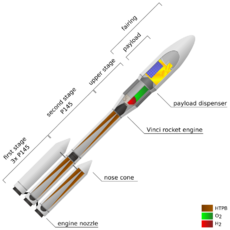
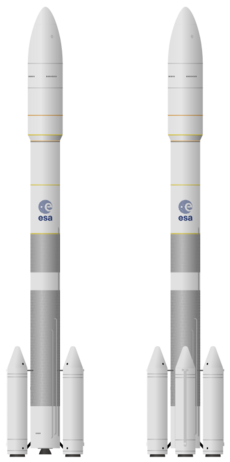
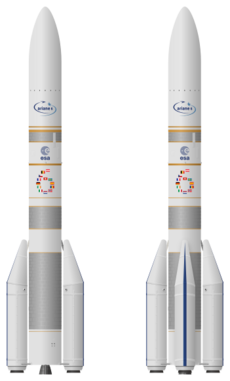
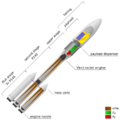


 In Spanish:
In Spanish: